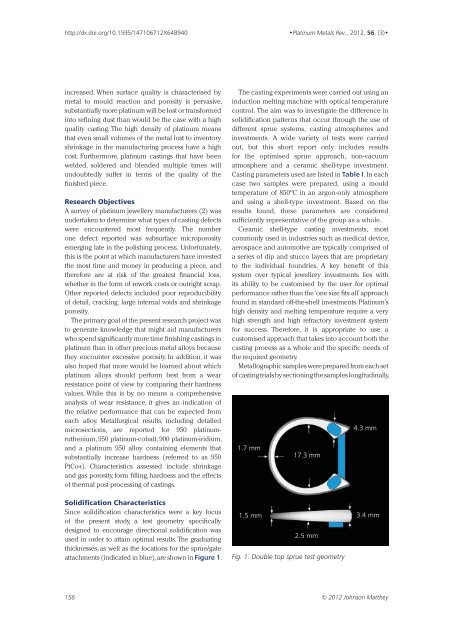Download article PDF - Platinum Metals Review
Download article PDF - Platinum Metals Review
Download article PDF - Platinum Metals Review
Create successful ePaper yourself
Turn your PDF publications into a flip-book with our unique Google optimized e-Paper software.
http://dx.doi.org/10.1595/147106712X648940<br />
•<strong>Platinum</strong> <strong>Metals</strong> Rev., 2012, 56, (3)•<br />
increased. When surface quality is characterised by<br />
metal to mould reaction and porosity is pervasive,<br />
substantially more platinum will be lost or transformed<br />
into refining dust than would be the case with a high<br />
quality casting. The high density of platinum means<br />
that even small volumes of the metal lost to inventory<br />
shrinkage in the manufacturing process have a high<br />
cost. Furthermore, platinum castings that have been<br />
welded, soldered and blended multiple times will<br />
undoubtedly suffer in terms of the quality of the<br />
finished piece.<br />
Research Objectives<br />
A survey of platinum jewellery manufacturers (2) was<br />
undertaken to determine what types of casting defects<br />
were encountered most frequently. The number<br />
one defect reported was subsurface microporosity<br />
emerging late in the polishing process. Unfortunately,<br />
this is the point at which manufacturers have invested<br />
the most time and money in producing a piece, and<br />
therefore are at risk of the greatest financial loss,<br />
whether in the form of rework costs or outright scrap.<br />
Other reported defects included poor reproducibility<br />
of detail, cracking, large internal voids and shrinkage<br />
porosity.<br />
The primary goal of the present research project was<br />
to generate knowledge that might aid manufacturers<br />
who spend significantly more time finishing castings in<br />
platinum than in other precious metal alloys because<br />
they encounter excessive porosity. In addition, it was<br />
also hoped that more would be learned about which<br />
platinum alloys should perform best from a wear<br />
resistance point of view by comparing their hardness<br />
values. While this is by no means a comprehensive<br />
analysis of wear resistance, it gives an indication of<br />
the relative performance that can be expected from<br />
each alloy. Metallurgical results, including detailed<br />
microsections, are reported for 950 platinumruthenium,<br />
950 platinum-cobalt, 900 platinum-iridium,<br />
and a platinum 950 alloy containing elements that<br />
substantially increase hardness (referred to as 950<br />
PtCo+). Characteristics assessed include shrinkage<br />
and gas porosity, form filling, hardness and the effects<br />
of thermal post-processing of castings.<br />
The casting experiments were carried out using an<br />
induction melting machine with optical temperature<br />
control. The aim was to investigate the difference in<br />
solidification patterns that occur through the use of<br />
different sprue systems, casting atmospheres and<br />
investments. A wide variety of tests were carried<br />
out, but this short report only includes results<br />
for the optimised sprue approach, non-vacuum<br />
atmosphere and a ceramic shell-type investment.<br />
Casting parameters used are listed in Table I. In each<br />
case two samples were prepared, using a mould<br />
temperature of 850ºC in an argon-only atmosphere<br />
and using a shell-type investment. Based on the<br />
results found, these parameters are considered<br />
sufficiently representative of the group as a whole.<br />
Ceramic shell-type casting investments, most<br />
commonly used in industries such as medical device,<br />
aerospace and automotive are typically comprised of<br />
a series of dip and stucco layers that are proprietary<br />
to the individual foundries. A key benefit of this<br />
system over typical jewellery investments lies with<br />
its ability to be customised by the user for optimal<br />
performance rather than the ‘one size fits all’ approach<br />
found in standard off-the-shelf investments. <strong>Platinum</strong>’s<br />
high density and melting temperature require a very<br />
high strength and high refractory investment system<br />
for success. Therefore, it is appropriate to use a<br />
customised approach that takes into account both the<br />
casting process as a whole and the specific needs of<br />
the required geometry.<br />
Metallographic samples were prepared from each set<br />
of casting trials by sectioning the samples longitudinally,<br />
1.7 mm<br />
17.3 mm<br />
4.3 mm<br />
Solidification Characteristics<br />
Since solidification characteristics were a key focus<br />
of the present study, a test geometry specifically<br />
designed to encourage directional solidification was<br />
used in order to attain optimal results. The graduating<br />
thicknesses, as well as the locations for the sprue/gate<br />
attachments (indicated in blue), are shown in Figure 1.<br />
1.5 mm<br />
2.5 mm<br />
Fig. 1. Double top sprue test geometry<br />
3.4 mm<br />
156 © 2012 Johnson Matthey
















